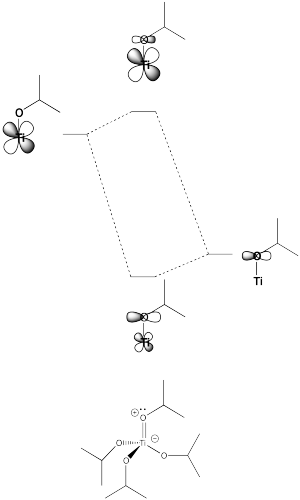CC10. Spectrochemical Series
Another factor that plays a key role in whether a transition metal complex is high- or low-spin is the nature of the ligands. The d orbital energy splitting is influenced by how strongly the ligand interacts with the metal. Ligands that interact only weakly produce little change in the d orbital energy levels, whereas ligands that interact strongly produce a larger change in d orbital energy levels.
The spectrochemical series is a list of ligands based on the strength of their interaction with metal ions. It is often listed, from weaker to stronger ligands, something like this:
I
− < Br− < S2− < SCN− < Cl− < NO3− < N3− < F− < OH− < C2O42− < H2O < NCS− < CH3CN < py < NH3 < en < bipy < phen < NO2− < PPh3 < CN− < COin which py = pyridine;
en = ethylenediamine;
bipy = 2,2'-bipyridine;
phen = 1,10-phenanthroline;
SCN means the ligand is bound via sulfur
NCS via nitrogen.
Figure CC10.1. The spectrochemical series.
The list can vary from one metal ion to another, since some ligands bind preferentially to certain metals (as seen in hard and soft acid and base chemistry).
Problem CC10.1.
What empirical trends can you see within the spectrochemical series? Are there any factors that make something a stronger field ligand?
The d orbitals that rise in energy in the presence of a ligand can be thought of as forming an antibonding molecular orbital combination with an orbital on the ligand. In addition, there would also be a bonding combination for this interaction. That bonding orbital would be more like the initial ligand orbital. This premise is based on the idea that a ligand orbital is initially lower in energy than the metal orbital, so a bonding combination between these two orbitals is more like the initial ligand orbital, both in energy and location. The d orbital is initially higher in energy than the ligand orbital, so an antibonding combination between these two orbitals is more like the initial d orbital, both in energy and location.
-
When orbitals on two different kinds of atoms combine, the antibonding orbital is considered to be more like the orbital that was initially at higher energy.
-
In this case, it is still close to a d orbital in energy, location, and shape.
-
When orbitals on two different kinds of atoms combine, the bonding orbital is considered to be more like the orbital that was initially at lower energy.
Problem CC10.2.
Suppose a ligand has more than one lone pair on the donor atom. The donor atom could share an extra pair of electrons with the metal, to form a double bond. This type of interaction is called pi-donation, because a pi bond is formed (not to be confused with sigma donation from a pi bond, as in alkene binding). Show an example using Ti(OiPr)4.
Problem CC10.3.
In an octahedral environment, three of the d orbitals were not affected by sigma donation from the ligands. Show what happens to the energy level of these d orbitals in the presence of a pi donor.
Problem CC10.4.
Some ligands can accept a pair of electrons from the metal. An example is a carbonyl complex, which has a C=O pi antibonding orbital that can interact with a d orbital.
a) Show the antibonding orbital on the carbonyl (CO) ligand.
b) Show how a metal d orbital can interact with this orbital.
Problem CC10.5.
In the previous problem, a lower-energy atomic orbital on the metal interacts with a higher-energy antibonding orbital on the ligand. Show what happens to the energies of these two orbitals when they interact with each other.
Some of the trends we see in the spectrochemical series arise from pi-donating and pi-accepting effects in the ligand. Ligands that have additional lone pairs (other than the one hat sigma donates) are pi donors. Pi donors raise the otherwise non-bonding t2g orbitals, because the lone pair on the ligand forms a pi bond with the metal. The t2g orbitals and the ligand lone pair orbitals form two new orbitals. The antibonding orbital is closer in energy to the high-energy d orbitals. The bonding orbital is closer in energy to the low-energy ligand orbital.
-
Pi donation raises the t2g set of d orbitals in energy.
-
As a result, the d orbital splitting gets smaller.
-
Also as a result, a complex with pi donation is a little less stable than a complex without pi donation.
This type of interaction can be seen in the following pictures (a tetrahedral case).

Figure CC10.2. An additional interaction with a π-donor in a coordination complex.
On the other hand, ligands in which the donor atom is already pi bonding to another atom can accept pi donation from the metal. This happens by donating an electron pair from a metal t2g orbital into a pi* orbital on the ligand. In this case, because the pi* is an antibonding orbital, it is higher in energy than the metal d orbital (or the t2g orbital). The resulting bonding orbital is more like the lower energy metal orbital, whereas the resulting antibonding orbital is more like the higher energy pi* orbital on the ligand.
-
Pi accepting ligands lower the t2g set of d orbitals in energy.
-
As a result, the d orbital splitting gets larger.
-
Also as a result, a complex with a pi accepting ligand is a little more stable than a complex without a pi accepting ligand.
This type of interaction can be seen in the following case (a tetrahedral complex).

Figure CC10.3. An additional interaction with a π-acceptor in a coordination complex.
The spectrochemical series gets its name because of a shift in a band of the UV-Vis spectrum when two similar complexes are compared that have two different ligands. The effect of the ligand on the d orbital splitting has an effect on the wavelength of light associated with a d orbital (filled) to d orbital (empty) electronic transition. This transition is actually not associated with a major absorption by the compound; d orbital transitions are actually not that efficient at absorbing light. However, because they often occur in the region of visible light, they often lead to coloured transition metal complexes.
The visible region includes photons with wavelengths from approximately 400 to 700 nm (really, a little bit lower and a little bit higher, but we are rounding). Photons with shorter wavelengths are invisible; if they are only a little shorter than visible light they are ultraviolet. Beyond that, photons with very, very short wavelengths are X-rays and gamma rays. Photons with longer wavelengths are also invisible; the infrared region is beyond about 700 nm. Beyond the infrared are microwaves and radio waves.

Figure CC10.4. A portion of the electromagnetic spectrum.
Note that it is sometimes easiest to approximate the bounds of visible light to the nearest hundreds. Usually say visible light has wavelengths between 400 and 700 nm.
When we observe an object, what we see is the light that bounces off the object. If all wavelengths of visible light bounces off the object, the object appears white. If all wavelengths of visible light is absorbed by the object, the object appears black. If very specific wavelengths of visible light are absorbed, we see the other wavelengths, but the actual colour that we perceive is slightly complicated, because of the way that we sense light.
In simple cases, the colour absorbed and the complementary colour that we see can be displayed using a colour wheel. The colour wheel displays the "complementary colours". When we see one of these colours, the light that is getting absorbed is the opposite one in the colour wheel.

Figure CC10.5. The colour wheel.
So, if we see something that looks bright blue, that object is really absorbing mostly orange light. If something absorbs violet light, it appears to us to have a yellow colour.
Note that the wavelengths of visible right run a little beyond 400 and 700 nm. Violet light goes all the way down to 380 nm, whereas red light goes almost to 750 nm.
Problem CC10.6.
Explain what happens to the wavelength of light absorbed for the d-d transition when a chloride ligand on a metal complex is replaced with a hydroxide ligand.
